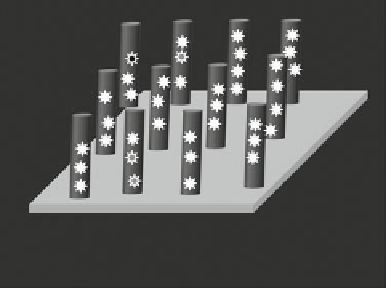Biomedical Engineering Reference
In-Depth Information
Fig. 4.23
CNT array
nanosyringe
drug 1
drug 3
drug 2
polymer coating
CNT
4.2
Biochips—DNA Arrays and Other Chips for Diagnosis
Biochips are miniaturized versions of an entire biochemical assay, which confer
many advantages over the conventional methods, such as (
Pasquarelli 2008
):
•
A relative large number of analytes can be simultaneously studied on the same
biological sample.
•
The needed quantity of a biological sample is quite small.
•
Very high efficiency.
There are several types of biochips, but the best known are DNA chips and protein
chips. The DNA chip (microarray) is a glass or quartz slide on which several probes
are deposited. A single probe is formed by the same molecule, and very often, a
probe is repeated several times on the slide to get a very high certitude of the results.
The DNA biochip is performing the tasks depicted in Fig.
4.24
.
The functionalization is the key issue of a DNA biochip. There are several
techniques to perform functionalization. The DNA solution is applied on the glass
slide with the help of a plotter-like robot with a spotting head. The plotter has an
array of needles, which are first dipped in a plate having several DNA sequences
in solution, and then the solutions are applied via a software program in the
desired places on the glass slide by direct contact printing, which releases the DNA
solution in the prescribed place. The spotting heads are similar to computer inkjet
printers. Subsequently, the DNA chip is immersed in a solution of analytes for
hybridization. The analytes contain also fluorophore molecules, which are necessary
for the readout step. The readout is implemented with a scanner, which detects the
fluorescence signal. The fluorophores are analyzed after being irradiated by a laser.
For example, if the DNA chip tagged with a green fluorophore is immersed in known
cancer cells tagged with a red fluorophore, and the scanner detects yellow spots, this
means that the two sequences present in the probe and the analyte have the same
gene sequence.
The additional functionalization of DNA sequences with quantum dots or
nanoparticles is increasing the intensity of the fluorescent signal. An alternative









Search WWH ::

Custom Search